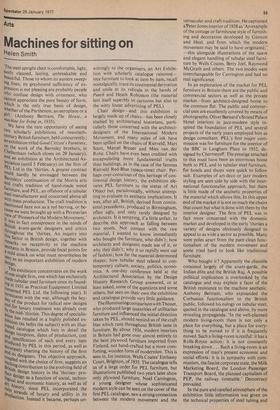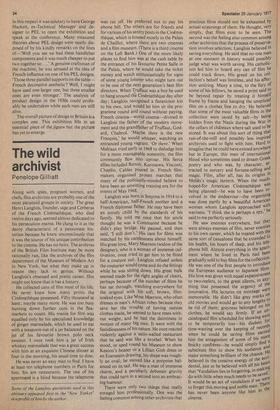Arts
Machines for sitting on
Helen Smith 'The steel upright chair is comfortable, light, easily cleaned, lasting, unbreakable and beautiful. Those to whom its austere sweeping lines, its greyhound sufficiency of exPression is not pleasing are probably people Who confuse design with ornament, who cannot appreciate the pure beauty of form, Which is the only true basis of design, Whether of the Parthenon, an aeroplane or a girl.' (Anthony Bertram, The House, a nlachine for living in, 1935). We have the rare opportunity of seeing two scholarly exhibitions of twentiethcentury British furniture, held concurrently; an exhibition titled Good Citizen's Furniture, °n the work of the Barnsley brothers, in Cheltenham (which closes on 29 January), and an exhibition at the Architectural Association (until 5 February) on the firm of PEL Ltd in the 'thirties. A greater contrast could hardly be envisaged between the aarnsleys' continuation of the Morris arts and crafts tradition of hand-made wood furniture, and PEL, an offshoot of a tubular steel manufacturer and concerned above all with mass production. The craft tradition is inentioned here not as a red herring, or because we were brought up with a Pevsnerian iew of 'Pioneers of the Modern Movement.' iht !vas in fact omnipresent in the minds of 'Nish avant-garde designers and critics ithhi.oughout the 'thirties. An inquiry into is factor in British design, together with entarks on receptivity to the machine aesthetic in Britain, provide focal points for :ernild attack on what must nevertheless be en as an important exhibition of modern uesign.
0:r his exhibition concentrates on the work noe single firm, one which has exclusively inad.e tubular steel furniture since its found(t,1,8 in 1931 as Practical Equipment Limited ;enaMed PEL Ltd. the following year). It ',ertninates with the war, although the heyuaaY of the product for radical new designs bncl fOr luxury treatment was already over 4y.t. the mid-'thirties. This degree of special'shas resulted in a highly polished ex(as befits the subject) with an illusdated catalogue which lists in detail the aerisigo inception, dates of production, cost nrd sPecification of each and every item ac°duced by PEL in this period, as well as ane..!jr.atelY charting the history of the firm eou its designers. This objective approach, P.led with the choice of firm, suggests an iire.tting contribution to the evolving field of dultish design history in the 'thirties: protor,e.t design as a function of social, techno:Ica! and economic history, as well as of historY, since PEL incorporated the
P _in strands of luxury and utility in its roduction. Instead it became, perhaps un
wittingly to the organisers, an Art Exhibition with scholarly catalogue raisonnenice furniture to look at item by item, recall nostalgically, trace its continental derivation and smile at its ridicule in the hands of Punch and Heath Robinson (the material lent itself superbly to cartoons but also to the witty linear advertising of PEL).
Chair design—and this exhibition is largely made up of chairs—has been closely studied by architectural historians, particularly those concerned with the architectdesigners of the International Modern Movement, and many miles of ink have been spilled on the chairs of Rietveld, Mart Stam, Marcel Breuer and Mies van der Rohe. Chairs have even been credited with encapsulating more fundamental truths than buildings, as in the case of the famous Rietveld Red-Blue (space-time) chair. Perhaps over-conscious of this heritage of continental design history, the exhibition elevates PEL furniture to the status of Art Object but, paradoxically, without attempting to evaluate its aesthetic implications. It was, after all, British, derived from continental precedents, produced in Birmingham, often ugly, and only rarely designed by architects. It is tempting, if a little unfair, to describe this approach as falling between two stools. Not content with the raw material, I wanted to know immediately who bought the furniture, who didn't; how architects and designers made use of it, or why they didn't; why it so rapidly went out of fashion; how far the material determined shapes; how tubular steel related to contemporary culture, society, politics, economics. A one-day conference held at the Architectural Association by the Design History Research Group answered, or at least asked, some of the questions and some others, but seen on their own the exhibition and catalogue provide very little guidance.
The illuminatingcomparison with Thonet, who produced large quantities of utilitarian furniture and influenced the initial direction taken by PEL, should remind us of the craft bias which runs throughout British taste in furniture. By about 1936, modern interiors in Britain had gone over almost entirely to the bent plywood furniture imported from Finland, not hand-crafted but a more comforting, wooden form of modernism. This is seen in, for instance, Wells Coates' Embassy Court, Brighton, of 1935. The catalogue tells us of a large order. for PEL furniture, but illustrations published two years later show only plywood furniture. Noel Carrington, a young designer whose sophisticated modern style can be seen on the cover of the first PEL catalogue, saw a strong connection between the modern movement and the vernacular and craft tradition, He captioned a'Peter Jones interior of 1938 as 'An example of the cottage or farmhouse style of furnishing and decoration developed by Gimson and Heal, and from which the modern movement may be said to have originated ;' —this alongside illustrations of the suave and elegant handling of tubular steel furniture by Wells Coates, Betty Joel, Raymond McGrath and others. The two modes were interchangeable for Carrington and had no real significance.
In an exploration of the market for PEL furniture in Britain there are the public and commercial sectors as well as the private market—from architect-designed home to the common flat. The public and commercial uses are excellently covered by means of photographs. Oliver Bernard's Strand Palace Hotel interiors in jazz-modern style inspired the foundation of PEL and several projects of the early years employed him as design consultant. PEL's first major commission was for furniture for the interior of the BBC in Langham Place in 1932, designed by Chermeyeff. The prestige attached to this must have been an enormous boost both to PEL and to tubular steel furniture, for hotels and shops were quick to follow suit. Examples of art-deco or jazz modern styling are seen side by side with the international functionalist approach, but there is little made of the aesthetic properties of the material which allows this. In this upper end of the market it is not so much the chairs that count but what is done with them by the interior designer. The firm of PEL was in fact more concerned with the domestic market and developed in the early 'thirties a variety of designs obviously designed to appeal to as wide a sector as possible. Many were poles apart from the pure clean functionalism of the modern movement and some tried hard to look like traditional furniture.
Who bought it ? Apparently the clientele consisted largely of the avant-garde, the Indian elite and the British Raj. A possible political implication is overlooked by the catalogue and may explain a facet of the British resistance to the machine aesthetic. Anthony Bertram, who expounded the Corbusian functionalism to the British public, followed his eulogy on tubular steel, quoted in the catalogue and above, by more revealing propaganda. 'In the well-planned modern living-room there is not only a place for everything, but a place for every thing to be moved to if it is frequently moved. Such a living-room is restful : it has a Rolls-Royce action: it is not constantly breaking down. . Such a living-room is an expression of man's present economic and social efforts: it is in sympathy with com munism, the fascist corporate state, the Milk Marketing Board, the London Passenger Transport Board, the planned capitalism of PEP, the railway timetable.' Democracy prevailed.
In the pure and rarefied atmosphere of the exhibition little information was given on the technical properties of steel tubing and
in this respect it was salutary to have George Hackett, ex-Technical Manager and designer to PEL to open the exhibition and speak at the conference. Many treasured theories about PEL design were neatly disposed of by his kindly remarks on the lines of—'Well you see we had these handlebar components and it was much cheaper to put two together so ...' A genuine craftsman of the machine, he was amused at the idea of Frekh influence on one of his PEL designs. 'Those three parallel supports on the table—. French decorative aesthetic? Well, I might have used one larger one, but three smaller ones are even stronger.' The analysis of product design in the 1930s could profitably be undertaken while such men are still alive.
The overall picture of design in Britain is a complex one. This exhibition fills in an essential piece of the jigsaw but the picture has yet to emerge.











































 Previous page
Previous page